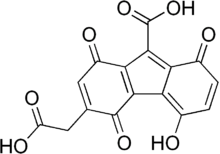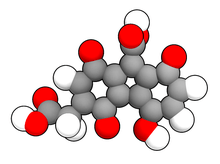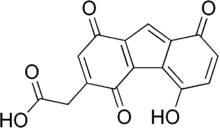Hipposudoric acid
Hipposudoric acid is a red pigment found in the skin secretions of the hippopotamus;[1] although the secretions are often known as "blood sweat" (thus the name "hipposudoric", referring to "hippo sweat"), they are neither blood nor sweat.
 | |
 | |
| Names | |
|---|---|
| IUPAC name
3-Carboxymethyl-5-hydroxy-1,4,8-trioxo-4,8-dihydro-1H-fluorene-9-carboxylic acid | |
| Identifiers | |
3D model (JSmol) |
|
| ChemSpider | |
PubChem CID |
|
CompTox Dashboard (EPA) |
|
| |
| |
| Properties | |
| C16H8O8 | |
| Molar mass | 328.232 g·mol−1 |
| Appearance | Red |
Except where otherwise noted, data are given for materials in their standard state (at 25 °C [77 °F], 100 kPa). | |
| Infobox references | |
Like its orange-colored analog norhipposudoric acid, hipposudoric acid functions both as a natural sunscreen and as an antimicrobial agent. It is derived from the oxidative dimerization of homogentisic acid.[2]

Norhipposudoric acid
References
- Kimiko Hashimoto; Yoko Saikawa; Masaya Nakata (2007). "Studies on the red sweat of the Hippopotamus amphibius" (PDF). Pure Appl. Chem. 79 (4): 507–517. doi:10.1351/pac200779040507.
- Moriya Kai; Matsuura Masanori; Saikawa Yoko; Hashimoto Kimiko; Yamaguguchi Ayumu; Sakamoto Kazuhiro; Akihisa Narito; Hirata Hiroyoshi (2006). "Properties of the enzyme responsible to the synthesis of hipposudoric and norhipposudoric acids, the pigments in the red sweat of the hippopotamus". Nippon Kagakkai Koen Yokoshu. 86 (2): 1314.
This article is issued from Wikipedia. The text is licensed under Creative Commons - Attribution - Sharealike. Additional terms may apply for the media files.